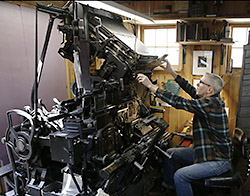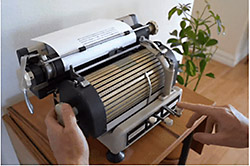Industrial Printing
This chapter covers the mechanization and automation of paper manufacture and printing starting in the 19th century CE, which up until the Industrial Revolution was entirely done by hand.
TOPICS
• Paper machines: Robert, Dickinson, Foudrinier
• Modern paper plant
• Printing presses: Stanhope, Koenig, Hoe, Bullock
• Typesetting: Linotype and Monotype
• Keyboards
• Modern printing: Lithography
• Phototypesetting
• Color printing: Color theory, process colors, offset litho, line screening
• Societal change: Labor shift, literacy, education
• Robert paper machine
• Dickinson paper machine
• Fourdrinier paper machine
• Modern paper plant
• Stanhope press
• Koenig press
• Koenig single cylinder operation - 3 panels
• Koenig double cylinder press
• Hoe rotary press
• Bullock web-fed rotary press
• Linotype machine
• Linotype machine operation
• Linotype keyboard
• Lithography
• Stanhope press with litho stone
• Metal litho plate
• Offset lithographic printing - 2 panels
• Phototypesetting perforator
• Phototypesetter
• Paste-up board
• Pica pole
• Process camera-plate maker
• Color theory
• Subtractive colors
• Color gamuts
• Offset litho press
• Color line screening
• Literacy rates by country, 1750-2015
• World rates of education 1820-2010
By the start of the 19th century, there had been little change in printmaking technology since Gutenberg’s press. Paper was still being made by hand much as it had been since its invention in China 1,700 years earlier, and presses, although more elaborate, still operated in the same way as Gutenberg’s, with type slugs set and inked, the paper positioned and the press bar pulled, all by hand.
The print industry was well established in most of the world. Printing houses employed a large workforce using what were called common presses, Gutenberg-style flat-bed and platen presses with hand-set type.
But rapid change was coming, as the first Industrial Revolution reached its apex and inventors sought their fortunes by designing machines to replace all that manual labor. Print technology would change rapidly over the next two centuries, first with the introduction of mechanical steam-powered presses, then rotary and continuous roll-fed presses that could print on both sides of the paper at once, and intricate machines for manufacturing complete lines of type in a single operation.
And then print technology would go in an entirely different direction, shifting to lithography, which allowed for flat printing plates without the need for type slugs at all. Lithography also made color printing more practical.
Paper making would also become mechanized, and wood pulp would largely replace rags and cotton, as large paper mills were built to satisfy the growing demand of the print industry.
And the demand was great. Even in the 20th century when competing electronic media appeared, the market for newspapers, magazines and books grew from year to year up to and through the start of the Digital Age. The 19th and 20th centuries were the golden age of printing.
Paper
Delaware Papermakers and Papermaking 1787-1840. Harold B. Hancock, Aug. 1955.
Paper. David Darling, daviddarling.info, 2016.
Delaware Papermakers and Papermaking, 1787-1840. Harold Bell Hancock, Eleutherian Mills-Hagley Foundation research reports (Accession 1645), 1955.
The Story of Paper-making. Frank O. Butler, J. W. Butler Paper Company, Jan. 1901. (Project Gutenberg ebook).
Delaware’s Industrial Brandywine. Hagley Museum, Wilmington, Delaware.
Thomas Gilpin Sets Up the First Papermaking Machine in America; the First Items Printed on his Machine-Made Paper. historyofinformation.com.
History of Paper Machines. historyofpaper.net.
Joe Miller's complete jest book: being a collection of the most excellent bon mots, brilliant jests, and striking anecdotes in the English language. Joe Miller (1684-1738). Scott, Webster, and Geary, 1840. University of Wisconsin Madison Libraries.
N.L. Robert’s Paper Machine (1799-1801). Oskars Pantelejevs, model maker.
Frogmore Paper Mill Museum, Hertfordshire, England.
The Fourdrinier Paper-Making Machine. Exerpt from Paper Manufacturing in the United States (1916). todayinsci.com.
Industrial Age Presses
A Catalogue of Nineteenth Century Printing Presses. Harold E. Sterne, Oak Knoll Press 2001.
American Iron Hand Presses. Stephen O. Saxe and John Depol, Oak Knoll Press 1992.
Frederick Koenig: Inventor of the Steam-printing Machine, pp. 274-319: Men of Invention and Industry. Samuel Smiles, Book Jungle 2008.
Richard March Hoe and the Evolution of Past Printing Presses. Henry Lewis Bullen, The Inland Printer Vol. 69 April 1922 pp. 851-854. Inland Printer Company, Chicago.
Richard Hoe: A powerful press opens mass media age. Frank Daniels III, The Tennessean, Sept. 14, 2012.
History of the Platen Press. Stephen Saxe, Letterpress Commons.
The International Printing Museum. Carson, CA.
Koenig’s mechanical press (early 19th century). britannica.com.
Earl Stanhope Invents the First Completely Iron Hand Press; Output Increases to 250 Sheets Per Hour. Jeremy Norman, historyofinformation.com.
Friedrich Koenig Invents the Steam-Powered Platen Press. Jeremy Norman, historyofinformation.com.
Stanhope. Briar Press, Letterpess Commons.
Koenig: his first Powered Printing Machines 1803 - 1818. letterpressprinting.com.
The history of print from 1850 to 1899. Laurens Leurs, prepressure.com.
Richard March Hoe and the Second Printing Revolution. Harald Sack, pscihi.org, Sept. 12, 2017.
Visit to Stanhope Press at Ditchling Museum. Peter Chasseaud, Tom Paine Printing Press, May 22, 2011.
Rotary printing press. wikiwand.com.
Linotype
Ottmar Mergenthaler: The Man and His Machine: A Biographical Appreciation of the Inventor on His Centennial. Basil Charles Kahan, Oak Knoll Press 1999.
Printing history and the Intertype linotype machine. Joan Boudreau, National Museum of American History, April 23, 2009.
A California Type Foundry Is Keeping Vintage Printing Alive. Glenn Fleishman, atlasobscura.com, Aug. 28, 2019.
With Linotype print, the old is new again. Brian MacQuarrie, The Boston Globe, Nov. 10, 2019.
The “Square Base” Linotype: 1890-1892 in the US. circuitousroot.com.
Phototypesetters: Reinventing the Printing Press. digitalcheck.com.
A Simple Operation. Alison Oswald, National Museum of American History, May 31, 2018.
Linotype and Intertype. letterpresscommons.com.
Otto Merganthaler and the Linotype. letterpresscommons.com.
Monotype. letterpresscommons.com.
Linotype Model 31. The Computer Museum.
Linotype Invented and Built in Baltimore. American Printing History Association, July 20, 2015.
The Invention of the Linotype Machine. Jienne Alhaideri, University of Michigan.
Celebrating Linotype, 125 Years Since Its Debut. John Hendel, The Atlantic, May 20, 2011.
Linotype Composing Machine, circa 1915. The Henry Ford Museum of American Innovation.
Etaoin shrdlu, anyone? Robert Messenger, oztypewriter.blogspot.com, Oct. 14, 2015.
Lithography
A History of Graphic Design. Philip B. Meggs, John Wiley & Sons 1998.
Exploring Typography. Tova Rabinowitz, Cengage Learning 2015.
Introduction to Photo-Offset Lithography. Kenneth F. Hird, Bennett Publishing Co. 1981.
Offset Printing Technology. S. Arunjunai Valavan and G. Venkateswaran, Arasan Ganesan Polytechnic College, Sivakasi 2018.
Understanding Photo Typesetting. Michael L. Kleper, North American Publishing Co. 1976.
Lithography. britannica.com.
Pioneers of Printing: Godefroy Engelmann. drupa.com, May 26, 2017.
A Printing Revolution: The History of Lithography. centrecolours.co.uk, Dec. 3, 2018.
The history of printing. prepressure.com.
Ira Rubel Invents the First Offset Press. Jeremy M. Norman, historyofinformation.com.
Lithography in the Nineteenth Century. Colta Ives, Department of Drawings and Prints, The Metropolitan Museum of Art, Oct. 2004.
A Short History of Offset Printing. offsetpressman.blogspot.com.
Offset Lithography. offsetprintingtechnology.com.
Lithographic offset press, Rubel. National Museum of American History.
Color printing
Why the Roots of Color Printing Are in Limestone. Ernie Smith, atlasobscura.com, April 25, 2017.
Coloritto / Harmony of colouring in painting. Le Blon, J. C, Howard Coppuck Levis, and Lessing J. Rosenwald Collection, Library of Congress. London, 1725. PDF.
2013 Conference: Seeing Color/Printing Color. Nina Schneider, Paul Romaine, Doug Clouse, Sara T. Sauers, Kseniya Thomas, Paul Moxon, Jessica Holada. American Printing History Association, Nov. 2013.
CMYK All The Way. Ernie Smtih, tedium.com, April 18, 2017.
Oldest magazines
How America’s Oldest Magazines Are Modernizing (And Monetizing) Their Archives. Michael Rondon, foliomag.com, Nov. 13, 2014.
Color in newspapers
The Challenge of Color. Harvard Business School Historical Collections, Melissa Banta curator.
The Rise of Color. Harvard Magazine, July-August 2010.
George Leighton Prints the "Illustrated London News" Christmas Supplement, the First Newspaper Printed in Color. Jeremy M. Norman, historyofinformation.com.
Newspapers’ Adoption of Color Nearly Complete. William Glaberson, The New York Times, May 31, 1993.
Phototypesetting
Fundamentals of Modern Photo-composition. John W Seybold, Seybold Publication 1979.
Introduction to Photo-Offset Lithography. Kenneth F. Hird, Bennett Publishing 1981.
Understanding Photo Typesetting. Michael L. Kleper, North American Publishing Co. 1976.
Digital Fonts: A condensed history. Alex Bigman, 99designs.com, 2016.
Scanning Around With Gene: Back When Typesetting was a Craft. Gene Gable, creativepro.com.
Phototypesetters: Reinventing the Printing Press. digitalcheck.com.
From Lead to Light: Lumitype, the First Successful Phototypesetting Machine, and the First Books it Typeset. Jeremy M. Norman, historyofinformation.com.
Typesetting. kymsinformation.wordpress.com.
Fonts were not always universal. Brian Lawler, thelawlers.com, Jan. 1, 2013.
Book publishing data
Inside Book Publishing 6th Edition. Giles Clark and Angus Phillips, Routledge 2019.
Production of manuscripts and books from 500 to 1800: ourworldindata.org/books.
Literacy rates
Central Intelligence Agency, The World Factbook.
UNESCO, Compendium of statistics on illiteracy, various editions.
UNESCO, Progress of Literacy in Various Countries, a Preliminary Statistical Study of Available Census Data since 1900, pdf 1953, accessed April 22, 2013.
UNESCO World Illiteracy at Mid-Century, pdf 1957, accessed April 21, 2013.
World Bank, World Development Indicators database.
The Growth of Literacy in Western Europe from 1500 to 1800. Dr. Robert A. Houston, University of St. Andrews, Feb. 18, 2018.
Literacy rate, adult total (% of people ages 15 and above). World Bank Group.
Literacy and Society in the West, 1500-1850. Rab Houston, Journal of Social History, Vol. 8, No. 3 (Oct. 1983), pp. 269-293 (25 pages). Taylor & Francis, Ltd.
Literacy. Max Roser and Esteban Ortiz-Ospina, Our World in Data, Sept. 20, 2018.
Literacy Rate By Country 2021. World Population Review.
Timeline
Printing 1770-1970: An Illustrated History of Its Development and Uses in England. Michael Twyman, British Library 1998.
Printing Presses: History and Development from the 15th Century to Modern Times. James Moran, University of California Press, 1978.
Printing Yesterday and Today. Harry Ransom Center, The University of Texas at Austin, 2018.
Mechanick Exercises: Or, The Doctrine Of Handy-Works. Joseph Moxon 1703 (reprinted by The Toolemera Press 2016).
The Press. Charles Apple, The Spokesman Review, June 28, 2020.
NOTE: Weblinks were current and active at the time of the last update to the site, but may have since become unavailable or outdated. If you encounter a dead link, please notify me at phil.loubere@mtsu.edu. Thanks.
Last update: May 2021
Content related to this chapter’s topics will be periodically posted here.
The Linotype machine

With Linotype print, the old is new again. Brian MacQuarrie, The Boston Globe, Nov. 11, 2019.
With over 36,000 parts, the Linotype machine was a marvel of the Industrial Age. This article interviews one of the few remaining operators.

This Small-Town Newspaper Is the Last of Its Kind. Nick Yetto, Smithsonian Magazine, April 2022.
The Saguache Crescent, a weekly in a Colorado hamlet, still prints on the 19th-century technology known as linotype.
US Magazines

How Magazines Helped Shape American History. Nora McGreevy, Smithsonian Magazine, Feb. 23, 2021.
Thanks to 19th-century technological advances in paper manufacture and printing, and with the development of offset lithography which made printing in color economical and practical, the 20th century was the golden age of magazine publishing. But magazines have been around since before the American Revolution. This article explores the influence that magazines had on US history.
Japanese typewriter

A Japanese typewriter. 'Typewriter Collector', Youtube, May 2, 2020.
This Toshiba typewriter types in Japanese, Chinese and English.
Last update: June 2022



